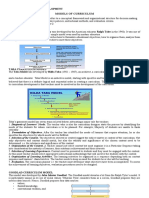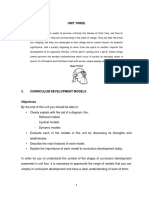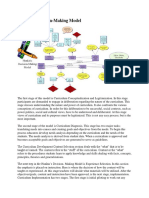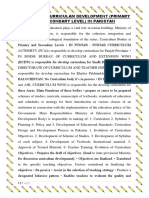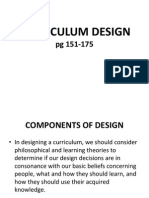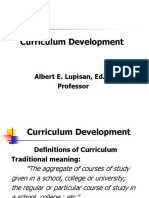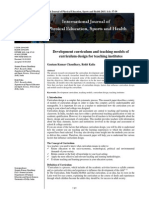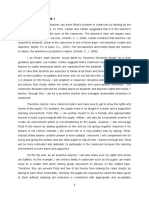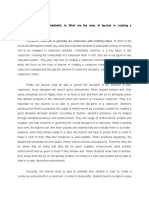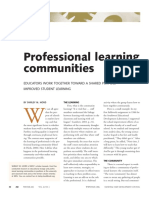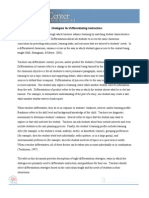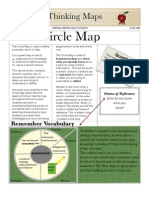0 ratings0% found this document useful (0 votes)
1K viewsHilda Taba Model of Curriculum Development: Presentation Topic
Hilda Taba Model of Curriculum Development: Presentation Topic
Uploaded by
preyangkaThe Taba Model of curriculum development, developed by Hilda Taba, uses an inductive approach where curriculum workers start with identifying learners' needs and expectations and build up the curriculum from there. The key steps in the Taba Model are: 1) Diagnosing learners' needs, 2) Formulating learning objectives, 3) Selecting learning content, 4) Organizing content, 5) Selecting learning experiences, 6) Organizing learning activities, and 7) Determining evaluation. While the Taba Model emphasizes teacher involvement, the Malaysian education system has a more centralized curriculum determined by the Ministry of Education.
Copyright:
© All Rights Reserved
Available Formats
Download as PPTX, PDF, TXT or read online from Scribd
Hilda Taba Model of Curriculum Development: Presentation Topic
Hilda Taba Model of Curriculum Development: Presentation Topic
Uploaded by
preyangka0 ratings0% found this document useful (0 votes)
1K views17 pagesThe Taba Model of curriculum development, developed by Hilda Taba, uses an inductive approach where curriculum workers start with identifying learners' needs and expectations and build up the curriculum from there. The key steps in the Taba Model are: 1) Diagnosing learners' needs, 2) Formulating learning objectives, 3) Selecting learning content, 4) Organizing content, 5) Selecting learning experiences, 6) Organizing learning activities, and 7) Determining evaluation. While the Taba Model emphasizes teacher involvement, the Malaysian education system has a more centralized curriculum determined by the Ministry of Education.
Original Title
Model Taba
Copyright
© © All Rights Reserved
Available Formats
PPTX, PDF, TXT or read online from Scribd
Share this document
Did you find this document useful?
Is this content inappropriate?
The Taba Model of curriculum development, developed by Hilda Taba, uses an inductive approach where curriculum workers start with identifying learners' needs and expectations and build up the curriculum from there. The key steps in the Taba Model are: 1) Diagnosing learners' needs, 2) Formulating learning objectives, 3) Selecting learning content, 4) Organizing content, 5) Selecting learning experiences, 6) Organizing learning activities, and 7) Determining evaluation. While the Taba Model emphasizes teacher involvement, the Malaysian education system has a more centralized curriculum determined by the Ministry of Education.
Copyright:
© All Rights Reserved
Available Formats
Download as PPTX, PDF, TXT or read online from Scribd
Download as pptx, pdf, or txt
0 ratings0% found this document useful (0 votes)
1K views17 pagesHilda Taba Model of Curriculum Development: Presentation Topic
Hilda Taba Model of Curriculum Development: Presentation Topic
Uploaded by
preyangkaThe Taba Model of curriculum development, developed by Hilda Taba, uses an inductive approach where curriculum workers start with identifying learners' needs and expectations and build up the curriculum from there. The key steps in the Taba Model are: 1) Diagnosing learners' needs, 2) Formulating learning objectives, 3) Selecting learning content, 4) Organizing content, 5) Selecting learning experiences, 6) Organizing learning activities, and 7) Determining evaluation. While the Taba Model emphasizes teacher involvement, the Malaysian education system has a more centralized curriculum determined by the Ministry of Education.
Copyright:
© All Rights Reserved
Available Formats
Download as PPTX, PDF, TXT or read online from Scribd
Download as pptx, pdf, or txt
You are on page 1of 17
Presentation topic :
HILDA TABA MODEL OF
CURRICULUM
DEVELOPMENT
Curriculum Models
WHAT IS CURRICULUM MODELS ?
• Curriculum model is a broad term referring to
the guide used to write curriculum guides, or
the documents used in education to determine
specific aspects of teaching, such as subject,
time frame, and manner of instruction.
• A simplified representation of reality which is
often depicted in diagrammatic form.
Curriculum Models
• Models serve as guidline to action.
• Models are found in almost every form of
education.
• The education profession has models of
instruction, of administration, of evaluation, of
supervision.
• Curriculum models are designed to provide a
basis for decisions regarding the selection,
structuring and sequencing of the educational
experiences
Hilda Taba
• The Taba Model was developed by Hilda Taba (1902
– 1967), an architect, a curriculum theorist, a
curriculum reformer, and a teacher educator.
• The Taba Model is used to enhance the thinking
skills of students. Hilda Taba believed that there
must be a process for evalutating student
achievement of content after the content standards
have been established and implemented.
• The main concept of this approach to curriculum
development is that teachers must be involved in
the development of the curriculum.
Taba’s philosophical ideas on
curriculum development
• Social processes, including the socialization of human
beings, are not linear, and they cannot be modeled
through linear planning. In other words, learning and
development of personality cannot be considered as
one-way processes of establishing educational aims
and deriving specific objectives from an ideal of
education proclaimed or imagined by some authority.
• The reconstruction of curriculam and programmes is
not a short-term effort but a long process, lasting for
years.
Taba’s philosophical ideas on
curriculum development
• Social institutions, among them school curriculam and
programmes, are more likely to be effectively rearranged
if, instead of the common way of administrative
reorganization—from top to bottom— a well-founded
and co-ordinated system of development from bottom
to top can be used.
• The development of new curriculam and programmes is
more effective if it is based on the principles of
democratic guidance and on the well-founded
distribution of work. The emphasis is on the partnership
based on competence, and not on administration.
Taba model
• Taba model is inductive approach.
• Taba model is teacher approach.
• Taba believe that teachers are aware of the
students needs hence they should be the one to
develop the curriculum.
• Taba’s is the Grass-root approach.
• The main idea to this approach is that the needs
of the students are at the forefront to the
curriculum.
Taba model
• Taba advocated an inductive approach to
curriculum development.
• In the inductive approach, curriculum
workers start with the specifics and
build up to a general design as opposed
to the more traditional deductive
approach of starting with the general
design and working down to the specifics.
Steps in Taba Model
1. Diagnosis of learners needs and
expectations of the larger society.
2. Formulation of learning objectives.
3. Selection of the learning content.
4. Organization of learning content.
5. Selection of the learning experiences.
6. Organization of learning activities.
7. Determination of what to evaluate and
the means of doing it.
Steps in Taba Model
Steps in Taba Model
Taba's model in relating to
Malaysian Education System
• According to Ministry of Education MOE, the
administration and management of education in
Malaysia is central.
• Teachers may only be involved in implementing the
curriculum while the main part of the curriculum is
determined by the Ministry of Education.
• Teacher should understand students' backgrounds,
cultures and how they learn.
• Teacher should be the researchers for their own
classroomsand of their own students.
Taba's model in relating to
Malaysian Education System
• Learners need to be able to connect the content to
the curriculum. If they are unable to do so, the
content is meaningless in their world.
• Students must employ their own experiences and
background knowledge to build upon when
learning newmaterials.
• Teacher should also finds ways to connect the
content to students’ lives.
Taba's model in relating to
Malaysian Education System
• The national curriculum be used in all school
(Malaysia – curriculum). There is a common central
assessment and examinations at the end of the
respective periods of schooling and the national
language, which is Malay is the official language of
instruction.
• Students’ maturity, academic achievement and
interests should be taken into consideration.
• Teacher should understand that not all students
learn the same way, and it is his responsibility to
provide a variety of instructional methods to the
students.
Taba's model in relating to
Malaysian Education System
• In taba' model teacher plays a major role in their
educational system but in today's Malaysian
educational system mostly student centered are
being used.
• Student centered learning focuses on the student
instead of the teacher.
• Student centered learning emphasizes the transfer
of knowledge and output from the students itself.
Taba's model in relating to
Malaysian Education System
• Having students learning through apps puts
teachers at a disadvantage in the classroom
because they are now faced with students who
show different levels of knowledge and skills. It
also puts pressure on teachers to rely more on
technology, not something many necessarily feel
comfortable with.
You might also like
- Critical Essay - Behaviour ManagementDocument7 pagesCritical Essay - Behaviour Managementapi-318838190100% (3)
- Tyler's Curriculum ModelDocument14 pagesTyler's Curriculum ModelSimple Lad100% (1)
- Models of CurriculumDocument5 pagesModels of CurriculumMarianne Parohinog75% (4)
- Chapter 5 Antiola. LEVELS OF CURRICULUM IMPLEMENTATIONDocument21 pagesChapter 5 Antiola. LEVELS OF CURRICULUM IMPLEMENTATIONIza Jay Trapa Donato100% (1)
- Models of Curriculum Development PPT 25 NOVDocument44 pagesModels of Curriculum Development PPT 25 NOVPriyanka SheoranNo ratings yet
- Curriculum Approaches and FoundationDocument9 pagesCurriculum Approaches and FoundationRodrick Sonajo Ramos100% (3)
- Taba Model of Curriculum DevelopmentDocument9 pagesTaba Model of Curriculum DevelopmentGeorgette Tapic100% (8)
- Curriculum Models Taba ModelDocument7 pagesCurriculum Models Taba ModelQurban AliNo ratings yet
- Curriculum Models and TypesDocument17 pagesCurriculum Models and TypesDana Caber83% (6)
- Models of Curriculum DevelopmentDocument17 pagesModels of Curriculum DevelopmentNaeem Jan100% (1)
- Stenhouse's ModelDocument9 pagesStenhouse's ModelSiehah Nasihah78% (9)
- Types of CurriculumDocument15 pagesTypes of CurriculumReanu Mithra67% (3)
- Kerr's ModelDocument8 pagesKerr's Modelkenzy142100% (3)
- English For Academic Purposes: Task 2: Oral Presentation (5%)Document11 pagesEnglish For Academic Purposes: Task 2: Oral Presentation (5%)preyangkaNo ratings yet
- 3rd Grade Fractions Unit PlanDocument10 pages3rd Grade Fractions Unit PlanSarah Sell100% (2)
- Taba ModelDocument29 pagesTaba ModelSALLY LEW100% (4)
- Hilda Taba ModelDocument14 pagesHilda Taba Modelkhairul80% (5)
- Curriculum Development Model NotesDocument4 pagesCurriculum Development Model NotesIan Mark Loreto Remanes100% (2)
- Taba's and Contemporary ModelDocument25 pagesTaba's and Contemporary ModelKlarisi VidalNo ratings yet
- Curriculum Components and ApproachesDocument6 pagesCurriculum Components and ApproachesRico BasilioNo ratings yet
- Curriculum Models.Document27 pagesCurriculum Models.given kalukangu100% (4)
- Hunkins ModelDocument2 pagesHunkins Modelstephen misoi100% (1)
- Development of Western Philosophy of EducationDocument23 pagesDevelopment of Western Philosophy of EducationHafiq Amsyar100% (1)
- Planned, Enacted & HiddenDocument7 pagesPlanned, Enacted & HiddenMuhammad Ismail50% (2)
- Curriculum Model: Is Defined As A Plan of Action That Can Be Employed From A Theory Into PracticeDocument21 pagesCurriculum Model: Is Defined As A Plan of Action That Can Be Employed From A Theory Into PracticeKritika Ramchurn100% (1)
- Classification of Curriculum ModelsDocument9 pagesClassification of Curriculum ModelsDinesh Madhavan100% (1)
- Assignment No. 1: Q.1 Discuss The Concept and Scope of CurriculumDocument19 pagesAssignment No. 1: Q.1 Discuss The Concept and Scope of CurriculumFaheem Elahi Fome50% (2)
- Historical Foundations of CurriculumDocument28 pagesHistorical Foundations of CurriculumJonnel GadinganNo ratings yet
- Approaches in Curriculum DevelopmentDocument2 pagesApproaches in Curriculum DevelopmentDominic Nobleza100% (1)
- Aims, Goals and Objective Purpose in Curriculum DevelopmentDocument19 pagesAims, Goals and Objective Purpose in Curriculum DevelopmentIshfaq100% (1)
- Types of Curriculum DesignsDocument3 pagesTypes of Curriculum DesignsJenica Cruz71% (7)
- Purpose of The CurriculumDocument4 pagesPurpose of The CurriculumMarivic RupilloNo ratings yet
- Administrative and Supervisory Structure in Pakistan: Unit 8Document27 pagesAdministrative and Supervisory Structure in Pakistan: Unit 8Ilyas Orakzai100% (2)
- Topic 4 - Elements of The CurriculumDocument26 pagesTopic 4 - Elements of The CurriculumKAETH LAURENCE ORILLA NOTARIONo ratings yet
- Role of Teacher in Curriculum DevelopmeDocument14 pagesRole of Teacher in Curriculum DevelopmeMadelyn Perigo100% (5)
- Process of Curriculaum Development in PakistanDocument6 pagesProcess of Curriculaum Development in PakistanMuhammad AkramNo ratings yet
- Madrassah, Origin, Aims and Objective:-: Unit No:-2 Madrassah EducationDocument1 pageMadrassah, Origin, Aims and Objective:-: Unit No:-2 Madrassah Educationmuhammad yousaf100% (1)
- Unit 3 Phases and Processes of Curriculum DevelopmentDocument4 pagesUnit 3 Phases and Processes of Curriculum DevelopmentDara Rose FilosofoNo ratings yet
- John Goodlad's Model of Curriculum Development: Individual Needs and Interests of LearnersDocument9 pagesJohn Goodlad's Model of Curriculum Development: Individual Needs and Interests of Learnerssimiyumark769No ratings yet
- Types of Curriculum EvaluationDocument9 pagesTypes of Curriculum EvaluationJonas Hapinat100% (1)
- Philosophy of EdDocument17 pagesPhilosophy of EdsikuetNo ratings yet
- Curriculum DesignDocument24 pagesCurriculum DesignHaziqah Izam100% (2)
- in Elements of The CurriculumDocument11 pagesin Elements of The CurriculumChristine L Dee29% (7)
- 1-Types of CurriculumDocument2 pages1-Types of CurriculumKhalid Mahmood80% (5)
- Objective ModelDocument5 pagesObjective ModelAyesha AhmedNo ratings yet
- Components of Curriculum DevelopmentDocument2 pagesComponents of Curriculum Developmentaluja100% (1)
- Approaches To Curriculum DevelopmentDocument16 pagesApproaches To Curriculum DevelopmentK100% (1)
- The Role of Stakeholders in Curriculum Implementation: Mr. Ronnie Z. Valenciano Jr. Bse 3BDocument28 pagesThe Role of Stakeholders in Curriculum Implementation: Mr. Ronnie Z. Valenciano Jr. Bse 3BWaynard Neil Lopez BuensucesoNo ratings yet
- Curriculum Development: Albert E. Lupisan, Ed.D. ProfessorDocument26 pagesCurriculum Development: Albert E. Lupisan, Ed.D. Professorvasil jiang100% (1)
- Curriculum DesignDocument45 pagesCurriculum DesignAntonio Delgado100% (1)
- Types of Curriculum DesignDocument2 pagesTypes of Curriculum DesignM Salman Awan100% (1)
- Definitions CurriculumDocument2 pagesDefinitions CurriculumShantiram Dahal100% (14)
- Teacher Centered Curriculum, The Role of Teachers & CurriculumDocument7 pagesTeacher Centered Curriculum, The Role of Teachers & CurriculumLawan YusufNo ratings yet
- Wheeler Model PDFDocument3 pagesWheeler Model PDFnorliyananingsih ideris80% (10)
- MODULE II The Teacher As A Curriculum PlannerDocument67 pagesMODULE II The Teacher As A Curriculum PlannerKrex Liquido100% (1)
- Curriculum Organization and DesignDocument5 pagesCurriculum Organization and DesignDonna Rillorta100% (1)
- Basic Phases of Curriculum Development Prepared by Phylla MagallanesDocument16 pagesBasic Phases of Curriculum Development Prepared by Phylla Magallanesjenibel100% (3)
- Ralph Tyler'S Model of Curriculum DevelopmentDocument6 pagesRalph Tyler'S Model of Curriculum DevelopmentRhiza PintoNo ratings yet
- Types of CurruculumDocument30 pagesTypes of CurruculumDante Gulapa0% (2)
- Tyler Objective ModelDocument32 pagesTyler Objective ModelZaman Rai100% (2)
- What Is Administrative Model of Curriculum?Document9 pagesWhat Is Administrative Model of Curriculum?Varun AmritwarNo ratings yet
- The Curriculum Should Be Designby Teachers BasedDocument4 pagesThe Curriculum Should Be Designby Teachers BasedRodel YapNo ratings yet
- Models of Curriculum: Mrutyunjaya Mishra Lecturer, H.IDocument51 pagesModels of Curriculum: Mrutyunjaya Mishra Lecturer, H.IBea Alyssa Galzote Bautista100% (1)
- Curriculum Design and Development-1Document93 pagesCurriculum Design and Development-1preyangkaNo ratings yet
- Digital Learning EnvironmentsDocument3 pagesDigital Learning EnvironmentspreyangkaNo ratings yet
- Kohlberg's Theory of Moral DevelopmentDocument9 pagesKohlberg's Theory of Moral DevelopmentpreyangkaNo ratings yet
- Child DevelopmentDocument7 pagesChild DevelopmentpreyangkaNo ratings yet
- Cohesive Markers: Lorem Ipsum DolorDocument9 pagesCohesive Markers: Lorem Ipsum DolorpreyangkaNo ratings yet
- Child Development Is The Process of Change and Stability in Children From Conception Through AdolescencesDocument7 pagesChild Development Is The Process of Change and Stability in Children From Conception Through AdolescencespreyangkaNo ratings yet
- Bilingualism and Second Language Teaching: Sorne Psychological Perspectives OnDocument11 pagesBilingualism and Second Language Teaching: Sorne Psychological Perspectives OnpreyangkaNo ratings yet
- Mak NG Nference: April 5, 2011 - TAKS Reading BlitzDocument22 pagesMak NG Nference: April 5, 2011 - TAKS Reading BlitzpreyangkaNo ratings yet
- Edu Assignment SampelDocument5 pagesEdu Assignment SampelpreyangkaNo ratings yet
- Language, Culture & SocietyDocument3 pagesLanguage, Culture & SocietypreyangkaNo ratings yet
- bbbbbbbbbbbbbbbbbbbbbbbbbb2. B) What Are The Roles of Teacher in Creating A Conducive Classroom?Document3 pagesbbbbbbbbbbbbbbbbbbbbbbbbbb2. B) What Are The Roles of Teacher in Creating A Conducive Classroom?preyangkaNo ratings yet
- Should Students Wear School UniformsDocument1 pageShould Students Wear School UniformspreyangkaNo ratings yet
- Cohesive Markers: Preethy Preyanka Qatrunnada Siti FadhilahDocument10 pagesCohesive Markers: Preethy Preyanka Qatrunnada Siti FadhilahpreyangkaNo ratings yet
- Academic Writing 2Document6 pagesAcademic Writing 2preyangkaNo ratings yet
- TSLB3023 English For Academic Purpose: Task 2:-Oral PresentationDocument9 pagesTSLB3023 English For Academic Purpose: Task 2:-Oral PresentationpreyangkaNo ratings yet
- Professional Communities Hord2009Document4 pagesProfessional Communities Hord2009api-356854001No ratings yet
- ThematicDocument12 pagesThematicSiti Hajar ZaidNo ratings yet
- Module 5Document1 pageModule 5MEGA MAURINE TIANo ratings yet
- Goals of Araling PanlipunanDocument9 pagesGoals of Araling PanlipunanMichele100% (8)
- Personalised Learning SpacesDocument4 pagesPersonalised Learning SpacesDan BuckleyNo ratings yet
- What Is Explicit InstructionDocument5 pagesWhat Is Explicit InstructionFrancis Mariñas RamosNo ratings yet
- Etwinning Would Like To Congratulate The 1,004 Schools That Have Been Awarded The Etwinning School Label 2019-2020Document2 pagesEtwinning Would Like To Congratulate The 1,004 Schools That Have Been Awarded The Etwinning School Label 2019-2020KRISTINA CONKINSKANo ratings yet
- Money Lesson Plan5Document2 pagesMoney Lesson Plan5api-312240430No ratings yet
- Tech Literacy - Victoria Bate - Excel Application AssignmentDocument2 pagesTech Literacy - Victoria Bate - Excel Application Assignmentapi-383558356No ratings yet
- Differentiation Strategies ToolDocument6 pagesDifferentiation Strategies ToolamyymaeducationNo ratings yet
- Curriculum Map in Computer Education 9: Pandan Bay Institute, IncDocument4 pagesCurriculum Map in Computer Education 9: Pandan Bay Institute, IncLeary John Herza Tambagahan100% (2)
- CefrDocument2 pagesCefrEmmanuel Zarcquel Petrus AtinNo ratings yet
- 12 EL 104 - Effective Programs in Bilingual EducationDocument3 pages12 EL 104 - Effective Programs in Bilingual EducationAngel Rodriguez100% (2)
- IV Day 9Document3 pagesIV Day 9Joevelyn Krisma CubianNo ratings yet
- DLL - ENGLISH Blank FormDocument4 pagesDLL - ENGLISH Blank FormMelinde BarluadoNo ratings yet
- Rebecca Lewis: EducationDocument2 pagesRebecca Lewis: Educationapi-457002987No ratings yet
- 4 DDocument4 pages4 Dapi-360778580No ratings yet
- DLL Sept23-27 EntrepDocument4 pagesDLL Sept23-27 EntrepJudel Aquino LumberaNo ratings yet
- SBM Benchmarking Lambingi, P. Septin & e Asion Activity DesignDocument5 pagesSBM Benchmarking Lambingi, P. Septin & e Asion Activity DesignJonas ForroNo ratings yet
- Slac SessionDocument4 pagesSlac SessionKurt Bantigue Catolico50% (2)
- N S C Teacher Preparation Program Lesson Plan Format: Description of Classroom: Background: Content Objective(s)Document2 pagesN S C Teacher Preparation Program Lesson Plan Format: Description of Classroom: Background: Content Objective(s)HCOblondey11No ratings yet
- Deductive Approach - Lesson Plan in Mathematics 2Document5 pagesDeductive Approach - Lesson Plan in Mathematics 2Shadz DhanNo ratings yet
- Episode 2 Guiding Principle in The Assessment of LearningDocument4 pagesEpisode 2 Guiding Principle in The Assessment of LearningBlessildajoy CruzNo ratings yet
- (Pengenalan) Teacher Sharing SessionDocument14 pages(Pengenalan) Teacher Sharing SessionZailina NaharNo ratings yet
- Photo Scavenger HuntDocument4 pagesPhoto Scavenger HuntBri AnthonyNo ratings yet
- Lesson Plan Template 1 2Document2 pagesLesson Plan Template 1 2api-378286868No ratings yet
- Circle MapDocument2 pagesCircle MapJaSon YkNo ratings yet
- Cañete, Jeramie - Chapter 4Document5 pagesCañete, Jeramie - Chapter 4Jeramie CañeteNo ratings yet
- Minutes of Meeting JuneDocument3 pagesMinutes of Meeting JunePaul BronNo ratings yet


